PSY10005 Research Methods: Critical Review of Sexting Among Youth
VerifiedAdded on 2023/06/16
|6
|1254
|495
Essay
AI Summary
This critical review examines sexting behavior among young adults in the US, focusing on its relationship with psychological well-being and risky sexual behavior. The review analyzes a study that investigates the prevalence of sexting and its association with demographic traits, erotic behaviors, and mental wellness. The study, involving participants aged 18-24, explores whether sexting is linked to sexual risk-taking and psychological distress, assessing factors like depression, anxiety, and self-esteem. While some research suggests a connection between sexting and mental health issues, this review highlights findings that show no significant correlation between sexting and psychological behaviors like low self-esteem or depression within the studied sample. The review also addresses limitations of the study, such as the lack of causal connections and the exclusion of senders in the analysis, emphasizing the need for further research to fully understand the implications of sexting among young adults. Desklib offers a wealth of similar solved assignments and study resources for students.

Running head: SEXTING CRITICAL REVIEW 1
Gordon et al., 2013
A critical review
Student’s Name
ELA Name
PSY 10005
Date
No. of Words
Gordon et al., 2013
A critical review
Student’s Name
ELA Name
PSY 10005
Date
No. of Words
Paraphrase This Document
Need a fresh take? Get an instant paraphrase of this document with our AI Paraphraser
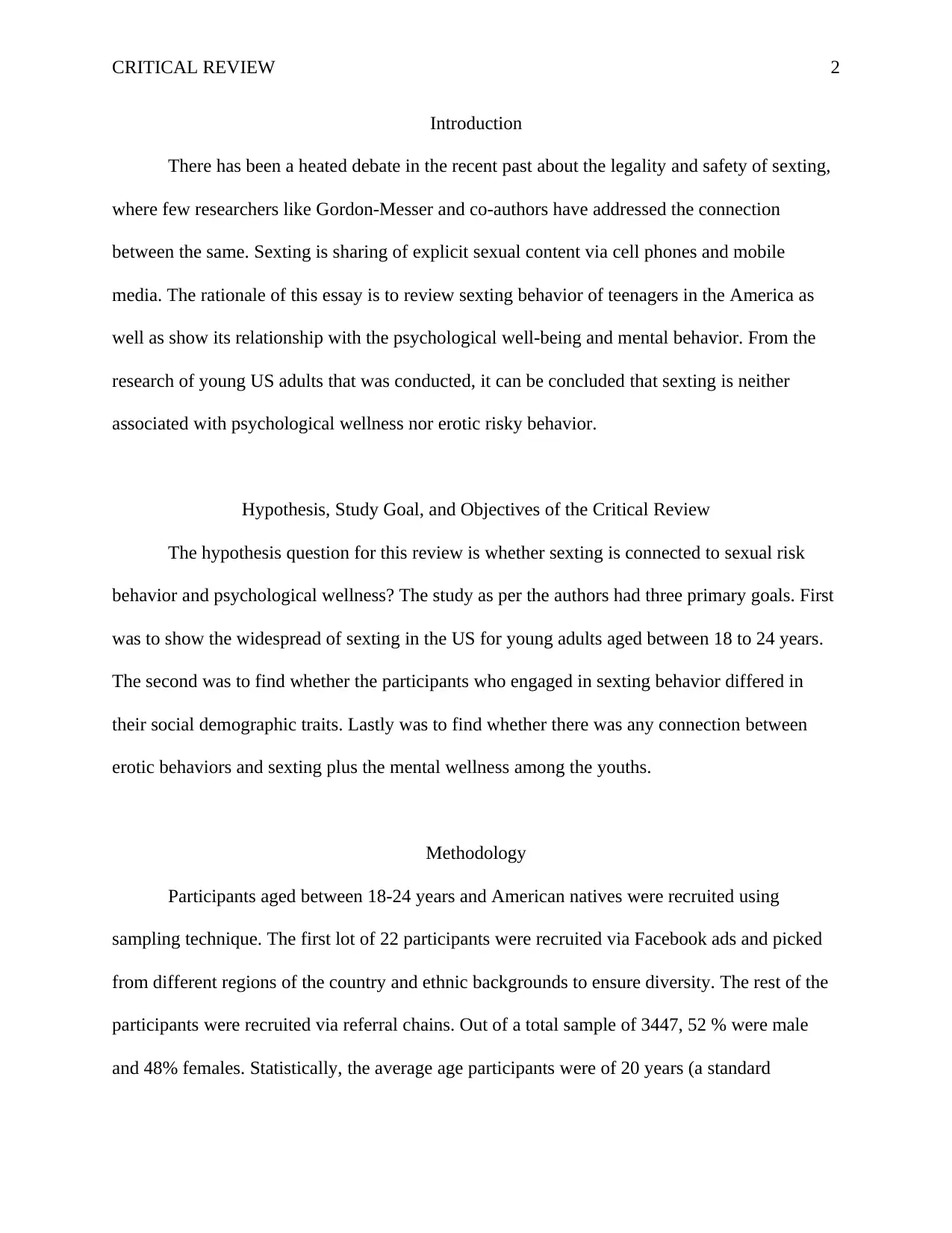
CRITICAL REVIEW 2
Introduction
There has been a heated debate in the recent past about the legality and safety of sexting,
where few researchers like Gordon-Messer and co-authors have addressed the connection
between the same. Sexting is sharing of explicit sexual content via cell phones and mobile
media. The rationale of this essay is to review sexting behavior of teenagers in the America as
well as show its relationship with the psychological well-being and mental behavior. From the
research of young US adults that was conducted, it can be concluded that sexting is neither
associated with psychological wellness nor erotic risky behavior.
Hypothesis, Study Goal, and Objectives of the Critical Review
The hypothesis question for this review is whether sexting is connected to sexual risk
behavior and psychological wellness? The study as per the authors had three primary goals. First
was to show the widespread of sexting in the US for young adults aged between 18 to 24 years.
The second was to find whether the participants who engaged in sexting behavior differed in
their social demographic traits. Lastly was to find whether there was any connection between
erotic behaviors and sexting plus the mental wellness among the youths.
Methodology
Participants aged between 18-24 years and American natives were recruited using
sampling technique. The first lot of 22 participants were recruited via Facebook ads and picked
from different regions of the country and ethnic backgrounds to ensure diversity. The rest of the
participants were recruited via referral chains. Out of a total sample of 3447, 52 % were male
and 48% females. Statistically, the average age participants were of 20 years (a standard
Introduction
There has been a heated debate in the recent past about the legality and safety of sexting,
where few researchers like Gordon-Messer and co-authors have addressed the connection
between the same. Sexting is sharing of explicit sexual content via cell phones and mobile
media. The rationale of this essay is to review sexting behavior of teenagers in the America as
well as show its relationship with the psychological well-being and mental behavior. From the
research of young US adults that was conducted, it can be concluded that sexting is neither
associated with psychological wellness nor erotic risky behavior.
Hypothesis, Study Goal, and Objectives of the Critical Review
The hypothesis question for this review is whether sexting is connected to sexual risk
behavior and psychological wellness? The study as per the authors had three primary goals. First
was to show the widespread of sexting in the US for young adults aged between 18 to 24 years.
The second was to find whether the participants who engaged in sexting behavior differed in
their social demographic traits. Lastly was to find whether there was any connection between
erotic behaviors and sexting plus the mental wellness among the youths.
Methodology
Participants aged between 18-24 years and American natives were recruited using
sampling technique. The first lot of 22 participants were recruited via Facebook ads and picked
from different regions of the country and ethnic backgrounds to ensure diversity. The rest of the
participants were recruited via referral chains. Out of a total sample of 3447, 52 % were male
and 48% females. Statistically, the average age participants were of 20 years (a standard
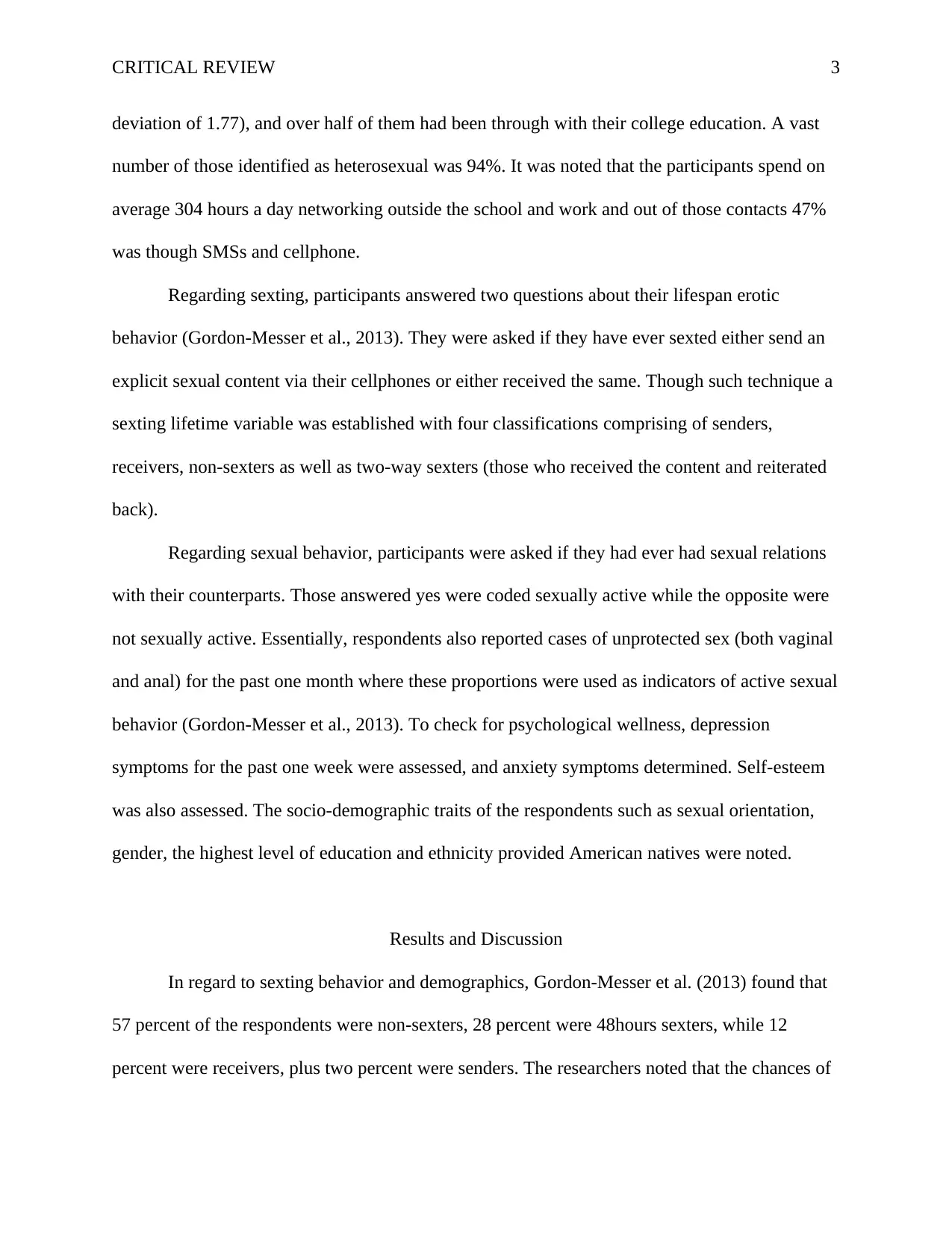
CRITICAL REVIEW 3
deviation of 1.77), and over half of them had been through with their college education. A vast
number of those identified as heterosexual was 94%. It was noted that the participants spend on
average 304 hours a day networking outside the school and work and out of those contacts 47%
was though SMSs and cellphone.
Regarding sexting, participants answered two questions about their lifespan erotic
behavior (Gordon-Messer et al., 2013). They were asked if they have ever sexted either send an
explicit sexual content via their cellphones or either received the same. Though such technique a
sexting lifetime variable was established with four classifications comprising of senders,
receivers, non-sexters as well as two-way sexters (those who received the content and reiterated
back).
Regarding sexual behavior, participants were asked if they had ever had sexual relations
with their counterparts. Those answered yes were coded sexually active while the opposite were
not sexually active. Essentially, respondents also reported cases of unprotected sex (both vaginal
and anal) for the past one month where these proportions were used as indicators of active sexual
behavior (Gordon-Messer et al., 2013). To check for psychological wellness, depression
symptoms for the past one week were assessed, and anxiety symptoms determined. Self-esteem
was also assessed. The socio-demographic traits of the respondents such as sexual orientation,
gender, the highest level of education and ethnicity provided American natives were noted.
Results and Discussion
In regard to sexting behavior and demographics, Gordon-Messer et al. (2013) found that
57 percent of the respondents were non-sexters, 28 percent were 48hours sexters, while 12
percent were receivers, plus two percent were senders. The researchers noted that the chances of
deviation of 1.77), and over half of them had been through with their college education. A vast
number of those identified as heterosexual was 94%. It was noted that the participants spend on
average 304 hours a day networking outside the school and work and out of those contacts 47%
was though SMSs and cellphone.
Regarding sexting, participants answered two questions about their lifespan erotic
behavior (Gordon-Messer et al., 2013). They were asked if they have ever sexted either send an
explicit sexual content via their cellphones or either received the same. Though such technique a
sexting lifetime variable was established with four classifications comprising of senders,
receivers, non-sexters as well as two-way sexters (those who received the content and reiterated
back).
Regarding sexual behavior, participants were asked if they had ever had sexual relations
with their counterparts. Those answered yes were coded sexually active while the opposite were
not sexually active. Essentially, respondents also reported cases of unprotected sex (both vaginal
and anal) for the past one month where these proportions were used as indicators of active sexual
behavior (Gordon-Messer et al., 2013). To check for psychological wellness, depression
symptoms for the past one week were assessed, and anxiety symptoms determined. Self-esteem
was also assessed. The socio-demographic traits of the respondents such as sexual orientation,
gender, the highest level of education and ethnicity provided American natives were noted.
Results and Discussion
In regard to sexting behavior and demographics, Gordon-Messer et al. (2013) found that
57 percent of the respondents were non-sexters, 28 percent were 48hours sexters, while 12
percent were receivers, plus two percent were senders. The researchers noted that the chances of
⊘ This is a preview!⊘
Do you want full access?
Subscribe today to unlock all pages.

Trusted by 1+ million students worldwide
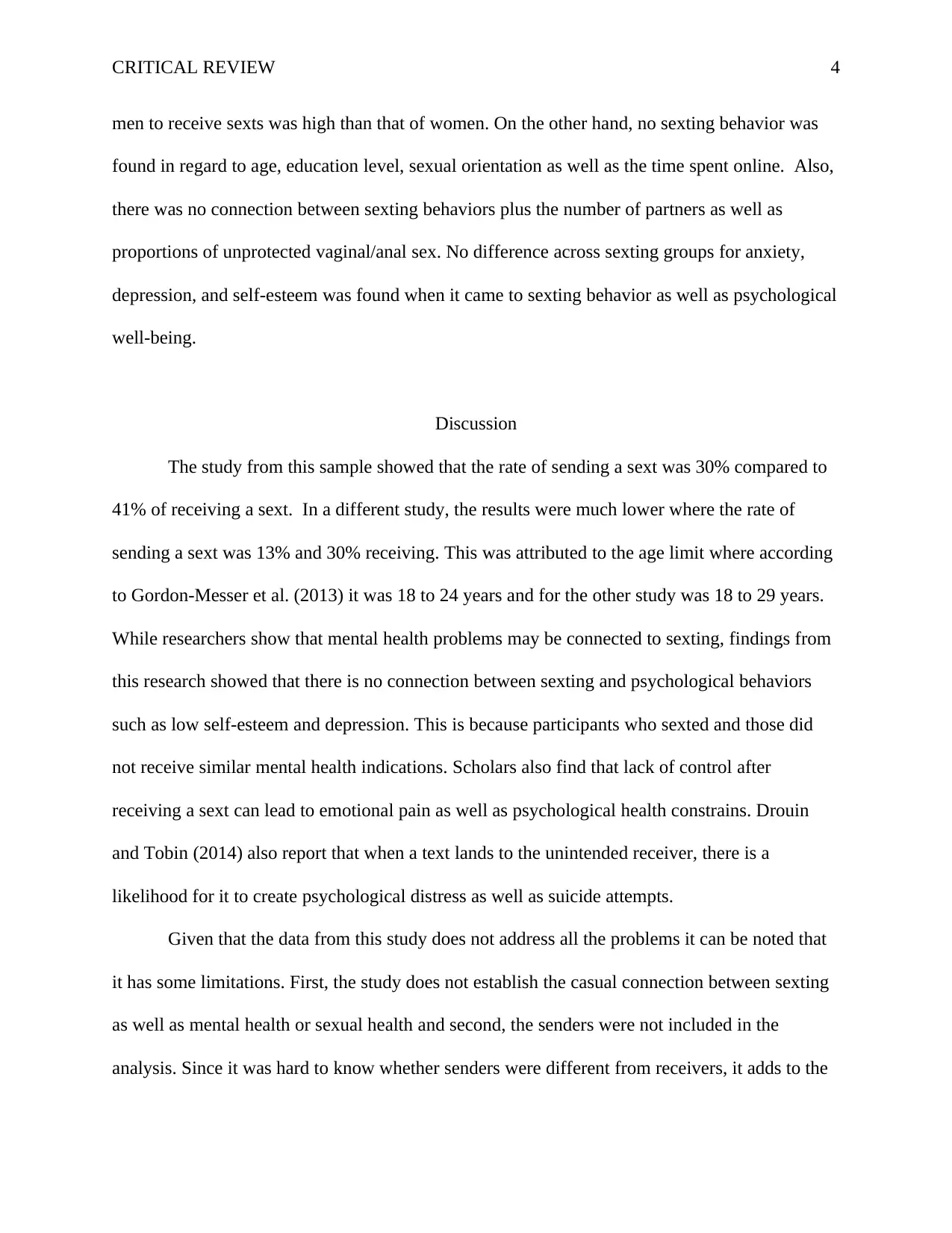
CRITICAL REVIEW 4
men to receive sexts was high than that of women. On the other hand, no sexting behavior was
found in regard to age, education level, sexual orientation as well as the time spent online. Also,
there was no connection between sexting behaviors plus the number of partners as well as
proportions of unprotected vaginal/anal sex. No difference across sexting groups for anxiety,
depression, and self-esteem was found when it came to sexting behavior as well as psychological
well-being.
Discussion
The study from this sample showed that the rate of sending a sext was 30% compared to
41% of receiving a sext. In a different study, the results were much lower where the rate of
sending a sext was 13% and 30% receiving. This was attributed to the age limit where according
to Gordon-Messer et al. (2013) it was 18 to 24 years and for the other study was 18 to 29 years.
While researchers show that mental health problems may be connected to sexting, findings from
this research showed that there is no connection between sexting and psychological behaviors
such as low self-esteem and depression. This is because participants who sexted and those did
not receive similar mental health indications. Scholars also find that lack of control after
receiving a sext can lead to emotional pain as well as psychological health constrains. Drouin
and Tobin (2014) also report that when a text lands to the unintended receiver, there is a
likelihood for it to create psychological distress as well as suicide attempts.
Given that the data from this study does not address all the problems it can be noted that
it has some limitations. First, the study does not establish the casual connection between sexting
as well as mental health or sexual health and second, the senders were not included in the
analysis. Since it was hard to know whether senders were different from receivers, it adds to the
men to receive sexts was high than that of women. On the other hand, no sexting behavior was
found in regard to age, education level, sexual orientation as well as the time spent online. Also,
there was no connection between sexting behaviors plus the number of partners as well as
proportions of unprotected vaginal/anal sex. No difference across sexting groups for anxiety,
depression, and self-esteem was found when it came to sexting behavior as well as psychological
well-being.
Discussion
The study from this sample showed that the rate of sending a sext was 30% compared to
41% of receiving a sext. In a different study, the results were much lower where the rate of
sending a sext was 13% and 30% receiving. This was attributed to the age limit where according
to Gordon-Messer et al. (2013) it was 18 to 24 years and for the other study was 18 to 29 years.
While researchers show that mental health problems may be connected to sexting, findings from
this research showed that there is no connection between sexting and psychological behaviors
such as low self-esteem and depression. This is because participants who sexted and those did
not receive similar mental health indications. Scholars also find that lack of control after
receiving a sext can lead to emotional pain as well as psychological health constrains. Drouin
and Tobin (2014) also report that when a text lands to the unintended receiver, there is a
likelihood for it to create psychological distress as well as suicide attempts.
Given that the data from this study does not address all the problems it can be noted that
it has some limitations. First, the study does not establish the casual connection between sexting
as well as mental health or sexual health and second, the senders were not included in the
analysis. Since it was hard to know whether senders were different from receivers, it adds to the
Paraphrase This Document
Need a fresh take? Get an instant paraphrase of this document with our AI Paraphraser
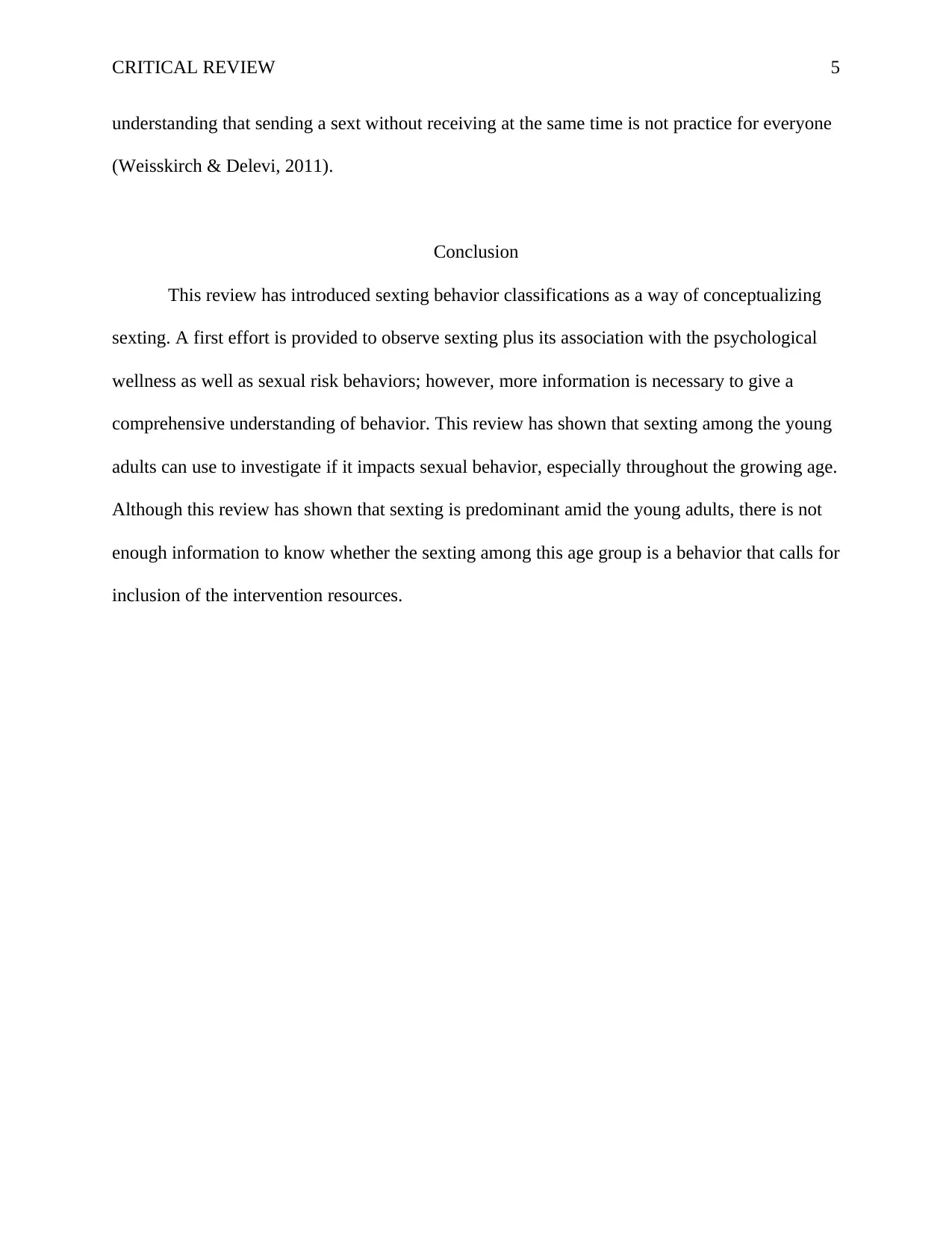
CRITICAL REVIEW 5
understanding that sending a sext without receiving at the same time is not practice for everyone
(Weisskirch & Delevi, 2011).
Conclusion
This review has introduced sexting behavior classifications as a way of conceptualizing
sexting. A first effort is provided to observe sexting plus its association with the psychological
wellness as well as sexual risk behaviors; however, more information is necessary to give a
comprehensive understanding of behavior. This review has shown that sexting among the young
adults can use to investigate if it impacts sexual behavior, especially throughout the growing age.
Although this review has shown that sexting is predominant amid the young adults, there is not
enough information to know whether the sexting among this age group is a behavior that calls for
inclusion of the intervention resources.
understanding that sending a sext without receiving at the same time is not practice for everyone
(Weisskirch & Delevi, 2011).
Conclusion
This review has introduced sexting behavior classifications as a way of conceptualizing
sexting. A first effort is provided to observe sexting plus its association with the psychological
wellness as well as sexual risk behaviors; however, more information is necessary to give a
comprehensive understanding of behavior. This review has shown that sexting among the young
adults can use to investigate if it impacts sexual behavior, especially throughout the growing age.
Although this review has shown that sexting is predominant amid the young adults, there is not
enough information to know whether the sexting among this age group is a behavior that calls for
inclusion of the intervention resources.
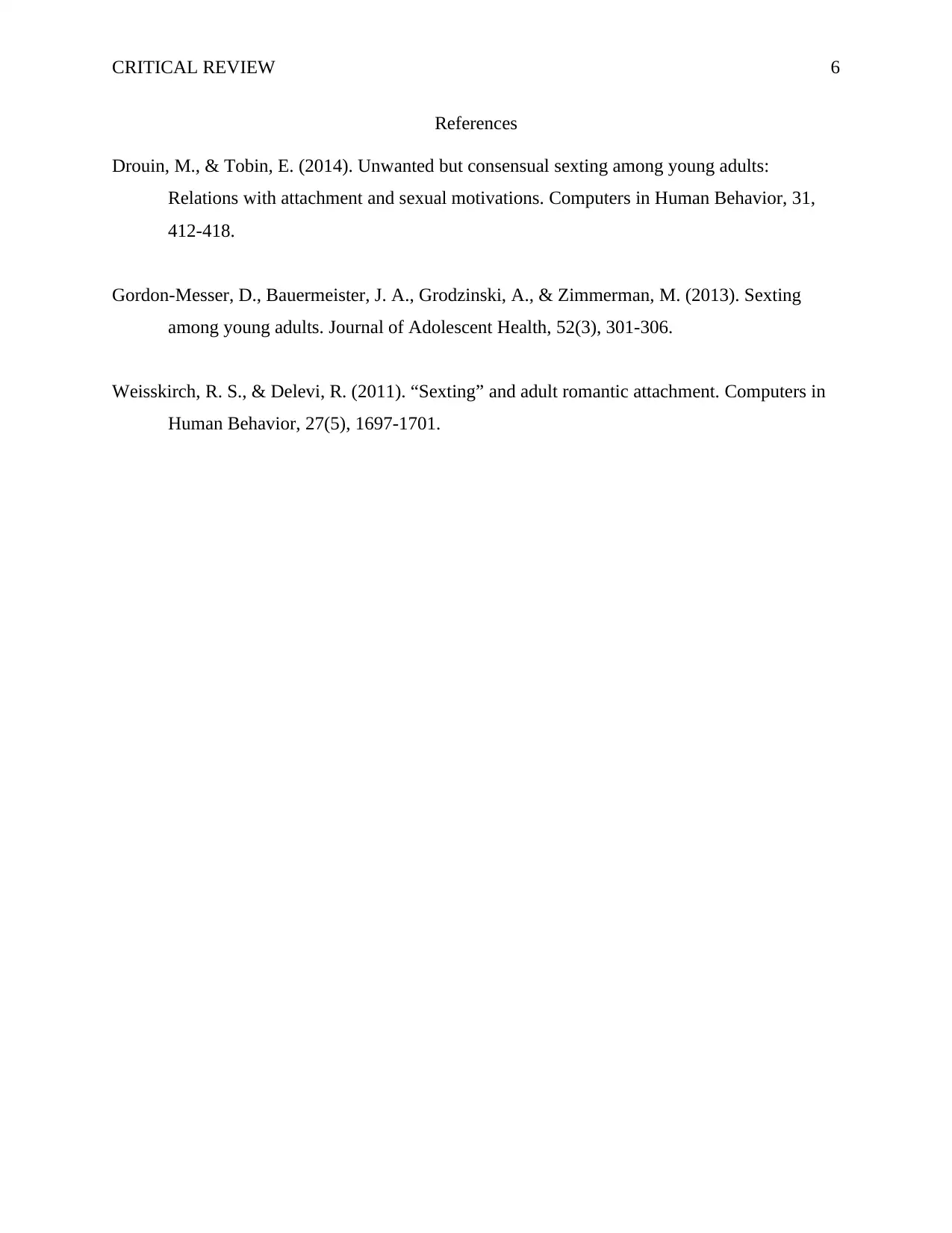
CRITICAL REVIEW 6
References
Drouin, M., & Tobin, E. (2014). Unwanted but consensual sexting among young adults:
Relations with attachment and sexual motivations. Computers in Human Behavior, 31,
412-418.
Gordon-Messer, D., Bauermeister, J. A., Grodzinski, A., & Zimmerman, M. (2013). Sexting
among young adults. Journal of Adolescent Health, 52(3), 301-306.
Weisskirch, R. S., & Delevi, R. (2011). “Sexting” and adult romantic attachment. Computers in
Human Behavior, 27(5), 1697-1701.
References
Drouin, M., & Tobin, E. (2014). Unwanted but consensual sexting among young adults:
Relations with attachment and sexual motivations. Computers in Human Behavior, 31,
412-418.
Gordon-Messer, D., Bauermeister, J. A., Grodzinski, A., & Zimmerman, M. (2013). Sexting
among young adults. Journal of Adolescent Health, 52(3), 301-306.
Weisskirch, R. S., & Delevi, R. (2011). “Sexting” and adult romantic attachment. Computers in
Human Behavior, 27(5), 1697-1701.
⊘ This is a preview!⊘
Do you want full access?
Subscribe today to unlock all pages.

Trusted by 1+ million students worldwide
1 out of 6
Your All-in-One AI-Powered Toolkit for Academic Success.
+13062052269
info@desklib.com
Available 24*7 on WhatsApp / Email
![[object Object]](/_next/static/media/star-bottom.7253800d.svg)
Unlock your academic potential
Copyright © 2020–2025 A2Z Services. All Rights Reserved. Developed and managed by ZUCOL.

